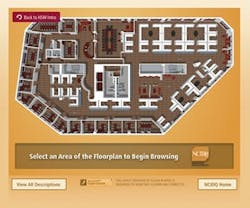NCIDQ News: First, Do No Harm
NCIDQ’s recent health, safety and welfare (HSW) Web site shows a three-dimensional view of a 15,000-square-foot corporate office interior. Viewers click on a quadrant of the plan and zoom in to see areas highlighted that demonstrate knowledge an interior designer must have to create a safe place. We wrote about the HSW site in a previous issue of Interiors & Sources and also distributed information to our Certificate holders via our newsletters.
We have received many suggestions and comments for further renditions of the site. One of the most popular is a request to show other types of spaces—like restaurants and retail stores—and indicate how elements in those spaces affect the public’s health, safety and well-being. Lately, I have started to think about what form a retail floor plan might take if we were to make it available on our 3-D Web site.
As I imagined a store for our HSW site, I found myself musing about the state of the retail industry right now, given a depressing economy and a desire by a growing population to abandon consumerism and to, instead, embrace “reuse” (or “don’t use”). However, at a recent visit to a local mall, one would not know a recession was in full swing in the Apple® store. Colorful iPod nano® and shuffle® mobile digital devices, and beautiful MacBook® computers with satin screens were being fondled, ogled and explored by five times more people per square foot than the equally popular shoe department at Saks. Was Apple a hit because of the lure of great store design—bright graphics and lighting—or was it the well-designed product itself, or people’s interest in anything tech-related? I wasn’t sure, but I couldn’t wait to trace my finger along a super sleek keyboard, or pick up the candy-colored second generation shuffle.
As I easily maneuvered through the space, I considered how a wheelchair user would experience this store. Universal Design principles abound at Apple. The counters are sleek and broad—all mounted at 34 inches above the floor … the same dimension required for an accessible counter for a wheelchair user (per the Americans with Disabilities Act guidelines). There is ample space between the parallel counters that hold all of the high-tech gadgetry—again, allowing easy access and passage of several people at a time. The floor is smooth and even, with no jarring change in carpet pile height, transition strips or other obstacles to cause unexpected trips or struggles with wheels. The store is inviting, brightly illuminated, clean and has powerful graphics. It also meets codes, is accessible and, from all appearances, is safe for the public to occupy.
I recently had an epiphany when a friend—a doctor who recently moved into her newly designed offices (not designed by me, I might add)—said to me, “You must walk into every place and notice the color on the walls.” I held my tongue, but I wanted to retort, “No, I am sitting here wondering why your doors do not have the proper minimum clearance to meet the ADA; why you have high-voltage, inefficient lighting that shines directly in patients’ eyes when they lie on the examination room table; why the counter in the public restroom is so high; and why there are regular flush (as opposed to low-flush) toilets.” Instead, because I value this friendship, I just nodded and said, “I notice a lot of things.”
And, I guess that is the struggle with being in a profession that deals directly with the health, safety and welfare of the public. I am in a stealth profession. I know my doctor has taken an oath to, “First, do no harm.” I know that in my practice—the fact that I am registered in Illinois and an NCIDQ Certificate holder—I, too, must do no harm. The public I am protecting, however, believes that my oath is, “make it pretty.”
Whether shopping in a store, working in an office building or eating at a restaurant, people need to know that their safety and well-being are my first priority in creating any interior space. If a space does no harm and looks beautiful, like the Apple store at my local mall, then I will consider my work successful.
Suzy Regitz is a member of the NCIDQ board of directors and an NCIDQ Certificate holder. She is president of Suzy’s Interiors in West Chicago, IL, and has operated her own residential and contract design business for 44 years, specializing in renovations and home offices. Regitz is a registered interior designer in Illinois. For more information on NCIDQ and to see the HSW Web site and 3-D tour, visit www.ncidq.org.
